Rural Scotland Business Panel Survey October 2022
This report presents findings from the third Rural Scotland Business Panel Survey carried out in June and July 2022.
2. Optimism and performance
Key findings
Just over four in ten (42%) businesses were confident in the economic outlook for Scotland over the next 12 months, while 56% were not. Economic optimism was down on the previous wave: 57% said their confidence had decreased, while 35% said it had stayed the same and 8% said it had increased.
Just under two thirds of businesses said they were now operating at either the same level (43%) or over and above the level (20%) they were before the COVID-19 pandemic. Around a third (36%) were operating below their pre-pandemic levels.
The vast majority of businesses (94%) were being impacted by rising costs (to at least a small extent). Three quarters (74%) were being impacted by COVID-19, 63% by EU Exit, and 58% by the Russia-Ukraine conflict.
Over the past six months, sales or turnover performance was mixed, while employment had remained relatively stable. Exports were more likely to have decreased than increased but had remained stable for a majority of businesses.
Around a third (35%) of businesses were operating behind where they wanted to be in relation to productivity, 29% in relation to adoption of technology, 20% skills development and 18% competitiveness.
Current economic optimism
Confidence in the economic outlook for Scotland was down compared to earlier this year: 42% of businesses were confident in June/July 2022 compared with 53% in February/April 2022. 56% of businesses were not confident (compared with 44% in February/April 2022) (Figure 2.1).
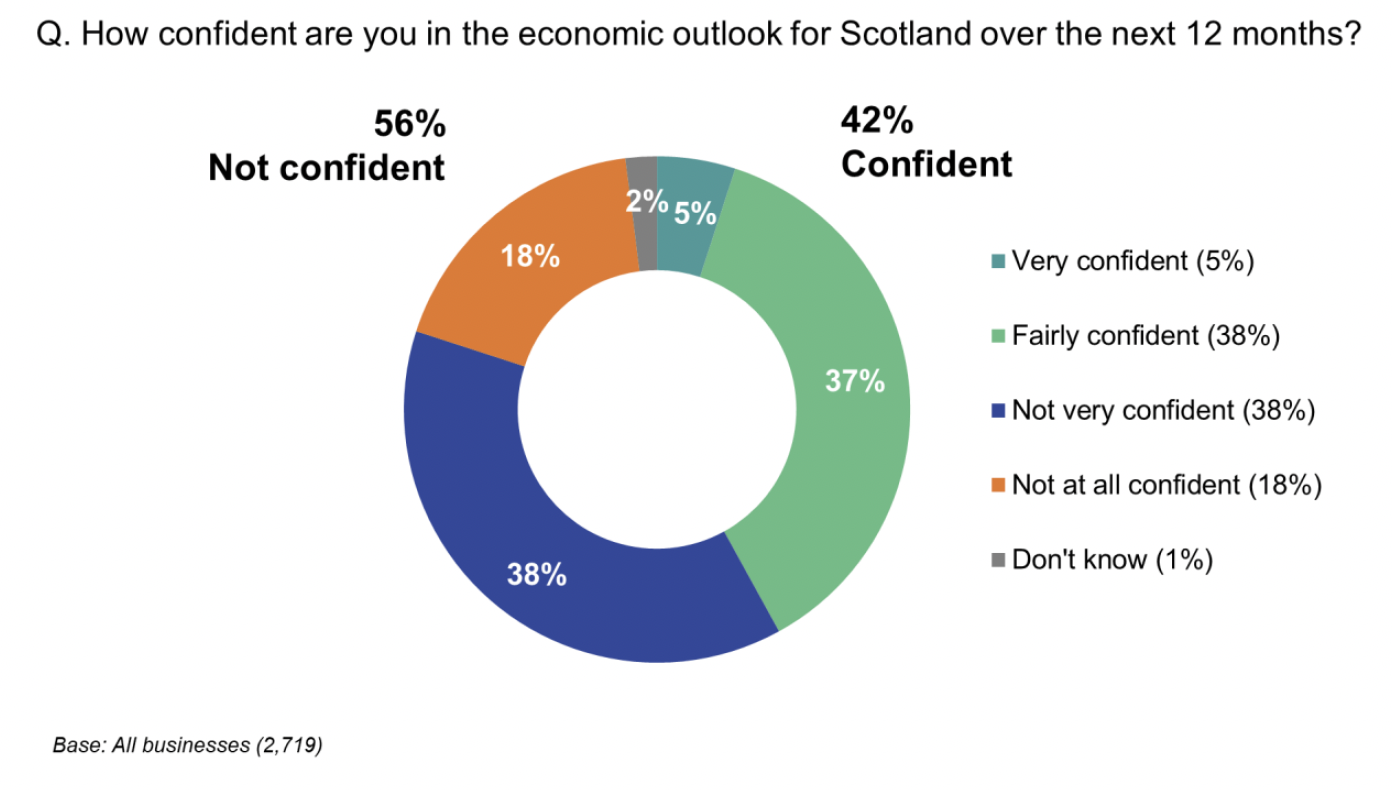
Variation in economic optimism
As seen in the previous survey, businesses in the Highlands and Islands were more confident (49%) than those in the South of Scotland (40%) and the rest of rural Scotland (40%).
Confidence in the economy was also higher than average among:
- those in small towns and peripheral urban locations (45% confident),
- those operating above the level they were before COVID-19 (57% confident), and
- those confident in the future viability of their business (46% confident).
Confidence was lower than average among:
- food and drink businesses (64% were not confident),
- sole traders and microbusinesses with 0-4 staff (58% not confident),
- those operating below the level they were before COVID-19 (68% not confident), and
- those not confident in their future viability (90% not confident).
Economic optimism over the past six months
Thinking about the preceding six months, 57% of businesses said their confidence had decreased. 35% said it had stayed the same and 8% said it had increased (Figure 2.2). Overall confidence[10] was -49, lower than the past two waves (-29 in Feb/April 2022 and -17 in October/November 2021).
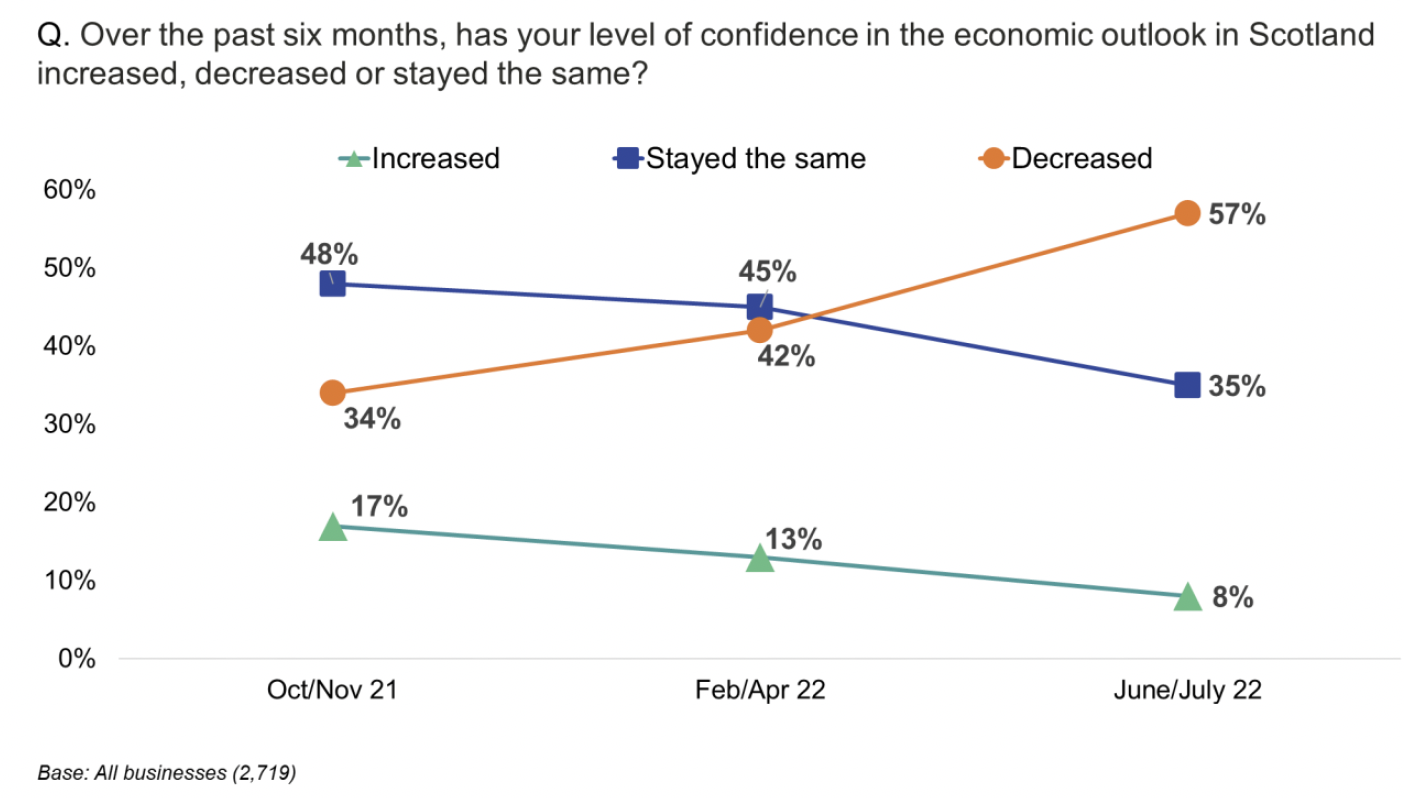
Variation in optimism over past six months
As in the previous wave, overall confidence was higher among businesses in the Highlands and Islands (-43) than in the South of Scotland (-50) and the rest of rural Scotland (-52). However, all regions still demonstrated a negative overall confidence.
Businesses more likely than average to say their confidence had increased were:
- creative industries (14%) and tourism (11%) businesses,
- those operating above their pre-pandemic levels (14%), and
- those selling to markets outside the UK (13%).
Those more likely to report decreased confidence were:
- food and drink businesses (63%),
- those in accessible rural areas (61%), and
- those operating below pre-pandemic levels (67%).
Level of current operation
Just under two thirds (63%) of businesses said they were now operating at either the same level (43%) or over and above the level (20%) they were before the COVID-19 pandemic. Around a third (36%) were operating below their pre-pandemic levels (Figure 2.3).
Compared with the previous wave (February/April 2022), there was an increase in the proportion saying they were operating in line with pre-pandemic levels, and a decrease in those operating below former levels.
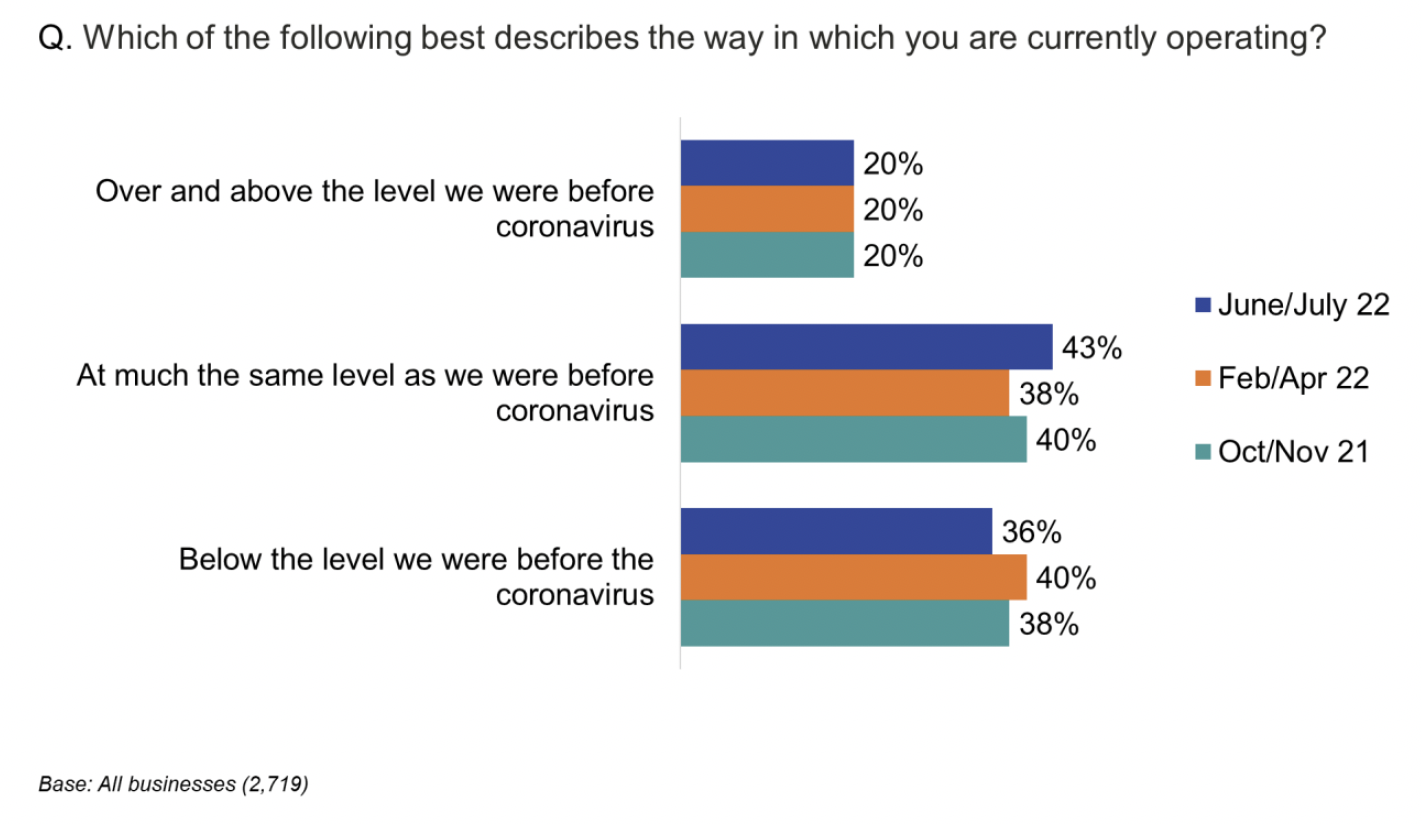
Variation in level of operation
As seen in the previous two waves, businesses in the rest of rural Scotland were more likely to be operating below their former levels (38%) compared with those in the Highlands and Islands (32%) and South of Scotland (29%) (Table 2.1).
| Operating level in relation to before the coronavirus | Highlands and Islands (%) | South of Scotland (%) | Rest of rural Scotland (%) | Total (%) |
|---|---|---|---|---|
| Over and above | 21 | 21 | 19 | 20 |
| At much the same level | 46 | 49 | 41 | 43 |
| Below | 32 | 29 | 38 | 36 |
| Base | 1,043 | 595 | 1,081 | 2,719 |
Other types of business more likely than average to be operating below pre-pandemic levels were:
- tourism businesses (50%),
- creative industries businesses (45%),
- those in small towns and peripheral urban locations (39%), and
- those who aimed to downsize (48%).
Those more likely to be operating over and above their former levels were:
- businesses with 11-24 (30%) and 25+ staff (30%), and
- those striving for growth (26%).
Businesses more likely than average to be operating at the same level as they were before were:
- food and drink businesses (65%),
- financial and business services (51%), and
- those in remote rural areas (51%).
External factors
The vast majority of businesses (94%) were being impacted by rising costs (to at least a small extent). Three quarters (74%) of businesses were still being impacted by the Coronavirus (COVID-19) pandemic, 63% by EU Exit, and 58% by the Russia-Ukraine conflict (Figure 2.4).
Around three in five (61%) businesses were being impacted to a large extent by rising costs, while 31% were being impacted to a large extent by Coronavirus (COVID-19), 25% by the Russia-Ukraine conflict, and 21% by EU Exit.
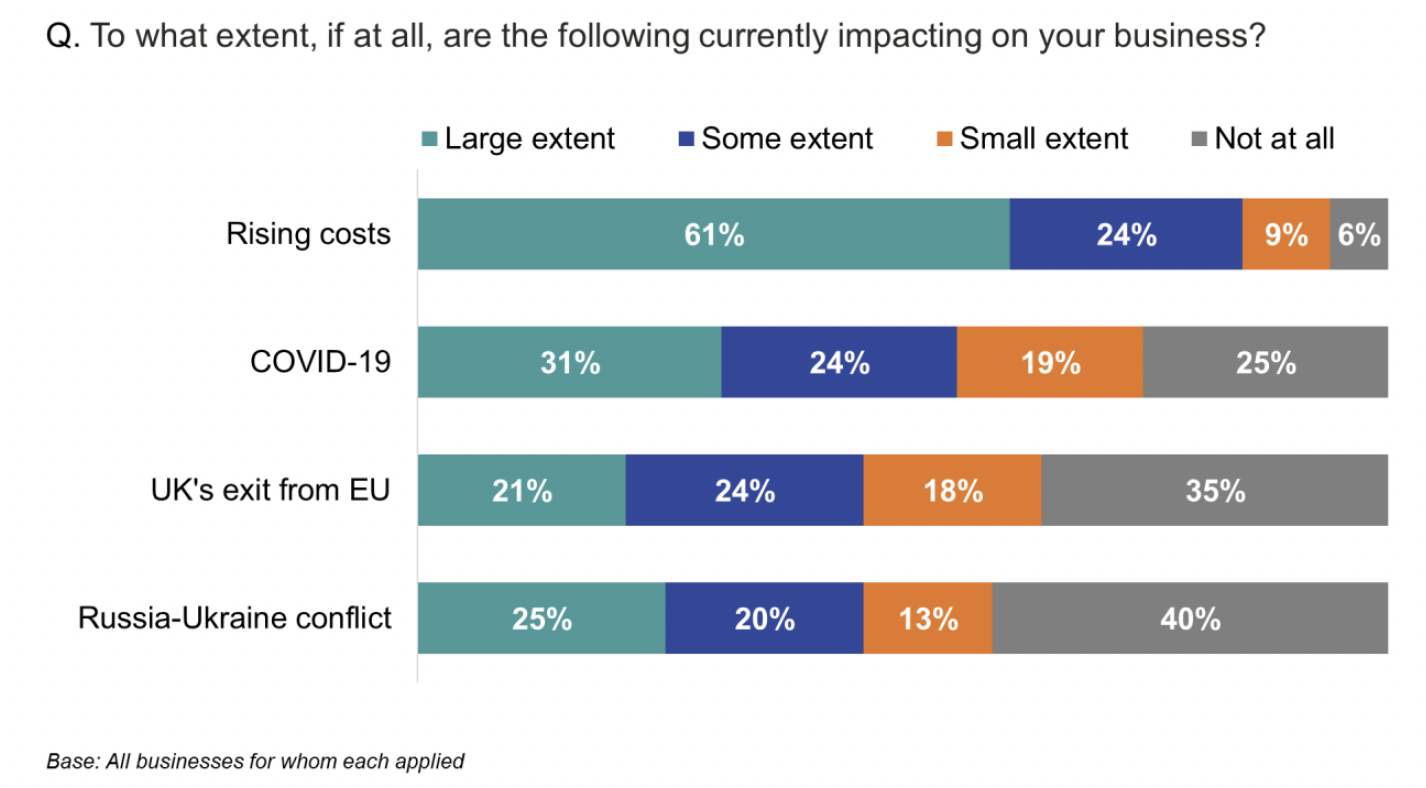
Variation in experience of external factors
Certain sectors were more likely than average to have been impacted by these external factors:
- Tourism – by rising costs (97% to at least a small extent), COVID-19 (87%) and EU Exit (71%).
- Food and drink – by rising costs (97% to at least a small extent), the Russia-Ukraine conflict (78%) and EU Exit (70%).
Businesses in the financial and business services sector, on the other hand, were more likely to say they were not impacted at all by the Russia-Ukraine conflict (64%), EU Exit (60%), or rising costs (15%).
Other businesses more likely to be impacted by certain factors were:
- remote rural businesses – by EU Exit (70% to at least a small extent) and the Russia-Ukraine conflict (64%).
- those importing from outside the UK – by rising costs (97% to at least a small extent), COVID-19 (81%), EU Exit (78%) and the Russia-Ukraine conflict (68%).
- those selling to markets outside the UK – by EU Exit (73% to at least a small extent).
Aspects of business performance
Over the past six months, sales or turnover performance was mixed: it had increased for 30% of businesses, decreased for 33%, and stayed the same for 36%.
In the same period, employment had remained relatively stable for most businesses (71%). Exports were more likely to have decreased than increased (27% vs 8%) but had remained stable for almost two thirds of businesses (63%) (Figure 2.5).
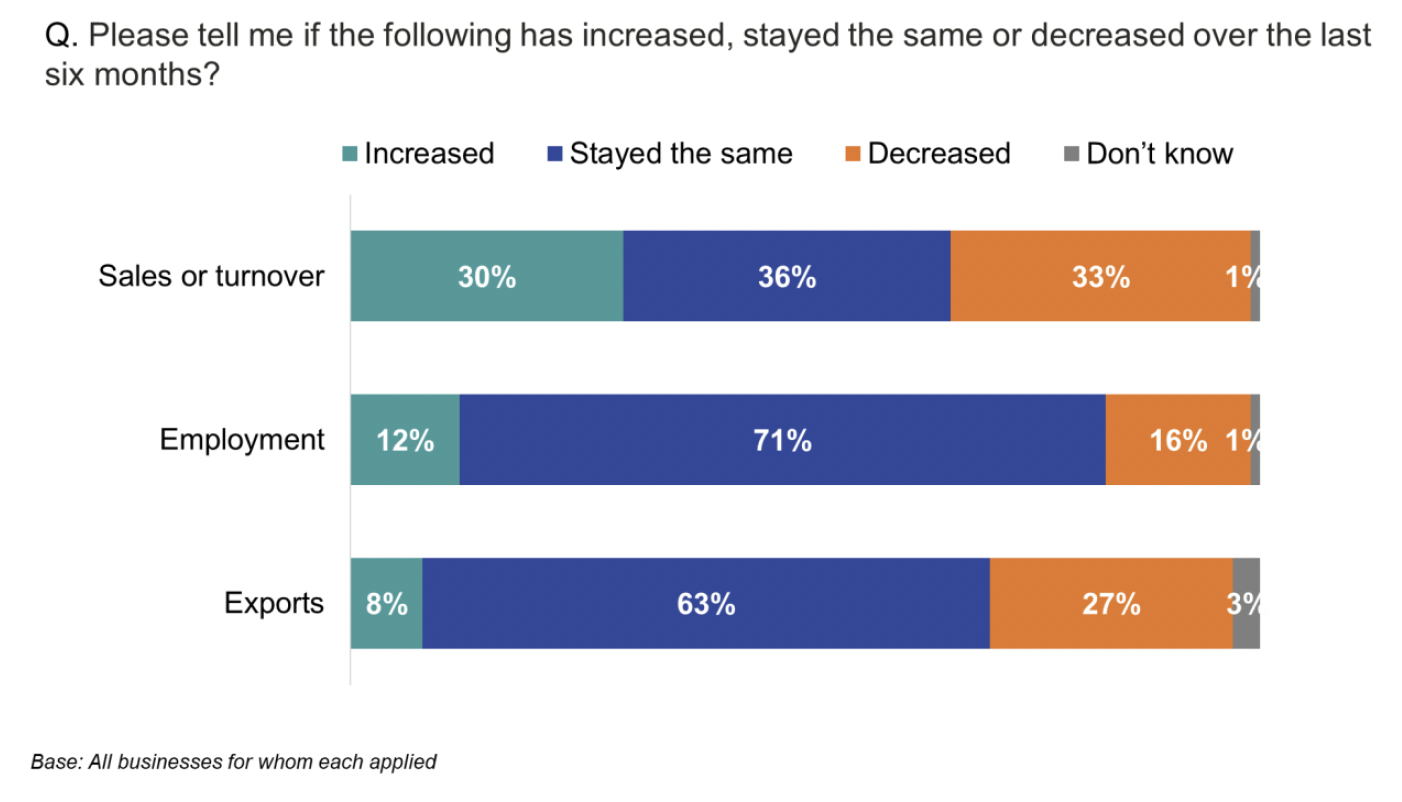
Variation in aspects of business performance
Tourism businesses were more likely than average to report decreases in sales or turnover (40%) and employment (30%). Food and drink businesses were more likely to report stability in both these aspects (49% and 82% respectively). Further variations are shown in Appendix A.
Performance against expectations
Most businesses were performing either in line with or over and above where they wanted to be on competitiveness (80%), skills development (78%), adoption of technology (70%) and productivity (64%) (Figure 2.6).
However, around a third (35%) were operating behind where they wanted to be in relation to productivity, 29% in relation to adoption of technology, 20% skills development, and 18% competitiveness.
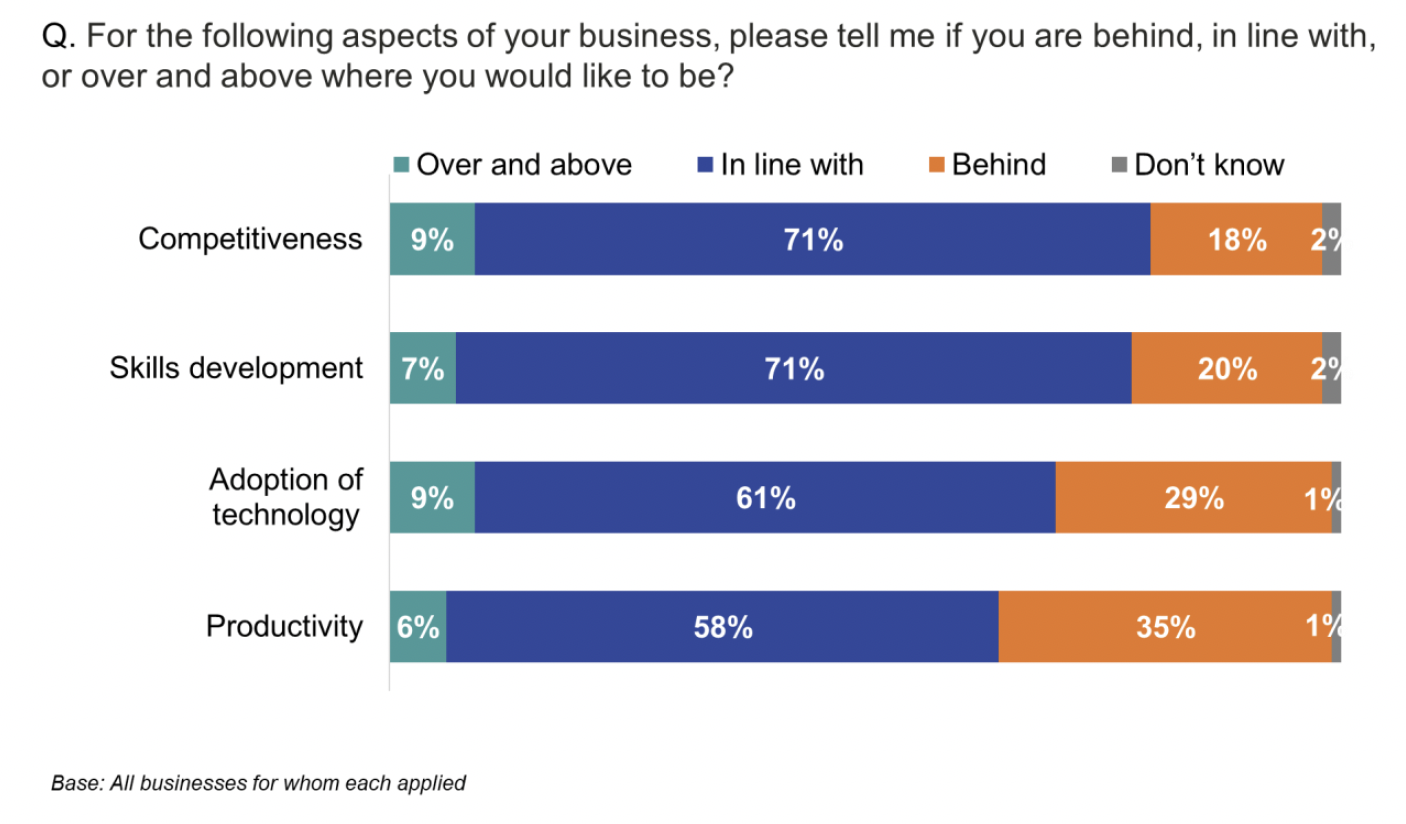
Variation in performance against expectations
The following sectors were more likely to be performing at certain levels:
- Food and drink – behind on skills development (25%) and competitiveness (22%), but in line with expectations on productivity (63%).
- Tourism – behind on skills development (29%).
- Financial and business services – over and above on adoption of technology (16%) and skills development (14%), and in line with expectations on productivity (66%).
On each measure, performance aligned with operating level:
- those operating below pre-COVID-19 levels were more likely to say they were performing behind where they wanted to.
- those operating in line with or above their former levels were more likely to also be performing in line with or over and above expectations.
Contact
Email: socialresearch@gov.scot
There is a problem
Thanks for your feedback